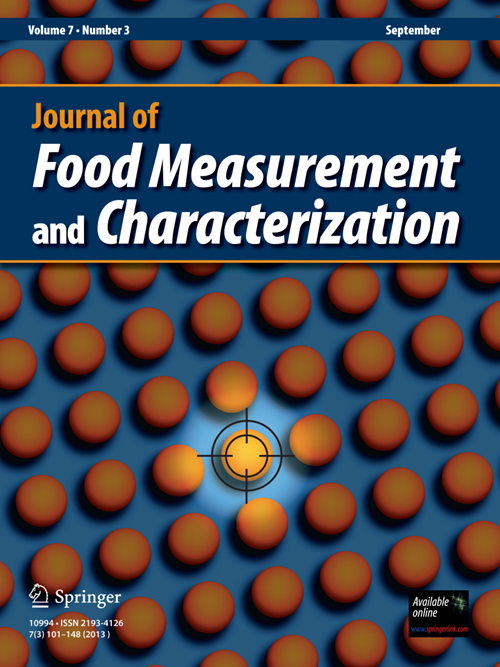差示扫描量热法作为一种评估冷压油在保质期内氧化状态的工具
IF 3.3
3区 农林科学
Q1 Engineering
Journal of Food Measurement and Characterization
Pub Date : 2023-10-24
DOI:10.1007/s11694-023-02152-8
引用次数: 0
摘要
冷榨油极易发生过氧化反应,导致其质量迅速下降。因此,有必要发展仪器方法,而不是传统的化学分析消耗大量的有害化学物质。差示扫描量热法(DSC)是评价油脂氧化稳定性的一种有价值的分析工具。对不同品种的冷压亚麻籽、亚麻荠籽和大麻籽油进行了测试,这些油在自然光照射下在室内条件下储存了6个月。测定油脂贮存过程中氧化稳定性变化的化学方法包括过氧化值(PV)、对茴香胺值(p-AV)、总氧化值(TOTOX)和酸值(AV)的测定。通过DSC曲线确定等温模式下(120、140℃)氧化诱导时间(OIT)和非等温模式下(升温速率2,5℃/min)起氧化温度(Ton)等参数。所有油类的OIT和Ton随时间的变化均呈显著(p≤0.05)下降趋势。然而,与亚麻籽油相比,亚麻籽油和大麻籽油在储存期间的变质速度更快。所有DSC结果都表明,三种类型的冷榨油的氧化特性具有良好的重复性,无论其来源是不同的栽培品种。然而,最适合监测油品贮存过程中变质变化的是在120°C温度下进行的等温试验,其与化学指标(PV、p- av、TOTOX)的相关性非常显著(p≤0.0001)。基于DSC结果的线性判别分析(LDA)表明,第一个判别函数能显著地将鲜油与储油分离开来。研究表明,基于对新鲜油脂的起点定义,DSC技术可用于有效和生态地监测油脂因氧化而变质,而不是有害的化学分析。本文章由计算机程序翻译,如有差异,请以英文原文为准。

Differential scanning calorimetry as a tool to assess the oxidation state of cold-pressed oils during shelf-life
Abstract Cold-pressed oils are highly prone to the peroxidation process, which causes a rapid decline in quality. Thus, there is a need to develop instrumental methods instead of conventional chemical analysis consuming large quantities of harmful chemicals. Differential scanning calorimetry (DSC) is a valuable analytical tool for assessing the oxidative stability of oils. Cold-pressed flaxseed, camelina and hemp seed oils from different cultivars, which had been stored for six months in room conditions under natural light exposure, were tested. Chemical methods for measuring changes in oxidative stability during storage of oils included determination of peroxide value (PV), p-Anisidine value (p-AV), total oxidation value (TOTOX) value and acid value (AV). Parameters like oxidation induction time (OIT) in isothermal mode (120, 140 °C) and onset temperature (Ton) in non-isothermal mode (heating rate 2, 5 °C/min) were established from DSC curves. Data for OIT and Ton plotted against time showed a strong, significant (p ≤ 0.05) descending trend for all oils. However, flaxseed and hempseed oils revealed a more rapid deterioration during storage compared to camelina seed oils. All DSC results showed promising repeatability of the oxidative characteristics for three types of cold-pressed oils, regardless of their origins in different cultivars. However, the most suitable for monitoring the deteriorative changes in oils during storage was the isothermal test carried out at a temperature of 120 °C, for which the correlations with chemical indicators (PV, p-AV, TOTOX) were highly significant (p ≤ 0.0001). Linear discriminant analysis (LDA) based on the DSC results revealed, that the first discriminating function significantly separated the fresh oils from stored oils. The study showed that, based on a starting point defined for fresh oils, the DSC technique can be used to effectively and ecologically monitor the deterioration of oils by oxidation, instead of harmful chemical analyses.
求助全文
通过发布文献求助,成功后即可免费获取论文全文。
去求助
来源期刊

Journal of Food Measurement and Characterization
FOOD SCIENCE & TECHNOLOGY-
CiteScore
5.30
自引率
11.80%
发文量
0
期刊介绍:
This interdisciplinary journal publishes new measurement results, characteristic properties, differentiating patterns, measurement methods and procedures for such purposes as food process innovation, product development, quality control, and safety assurance.
The journal encompasses all topics related to food property measurement and characterization, including all types of measured properties of food and food materials, features and patterns, measurement principles and techniques, development and evaluation of technologies, novel uses and applications, and industrial implementation of systems and procedures.
 求助内容:
求助内容: 应助结果提醒方式:
应助结果提醒方式:


